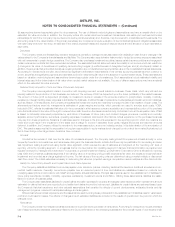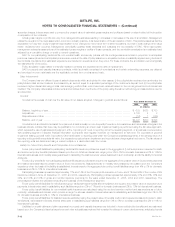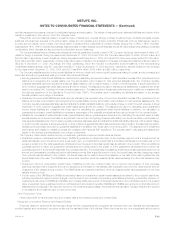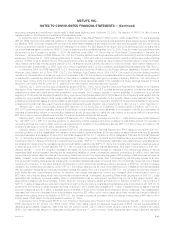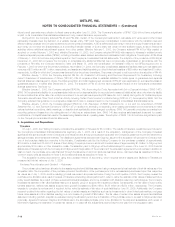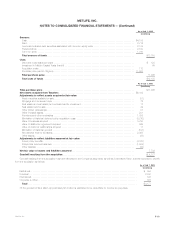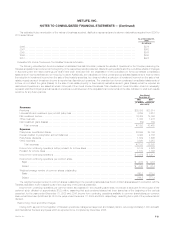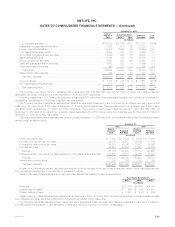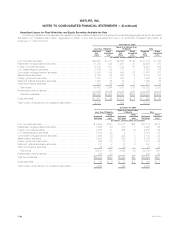MetLife 2005 Annual Report Download - page 78
Download and view the complete annual report
Please find page 78 of the 2005 MetLife annual report below. You can navigate through the pages in the report by either clicking on the pages listed below, or by using the keyword search tool below to find specific information within the annual report.METLIFE, INC.
NOTES TO CONSOLIDATED FINANCIAL STATEMENTS — (Continued)
when considering whether an entity qualifies as a QSPE. Under FSP 140-2, the criteria must only be met at the date the QSPE issues beneficial interests
or when a derivative financial instrument needs to be replaced upon the occurrence of a specified event outside the control of the transferor. FSP 140-2
did not have a material impact on the Company’s consolidated financial statements.
In September 2005, the American Institute of Certified Public Accountants (‘‘AICPA’’) issued SOP 05-1, Accounting by Insurance Enterprises for
Deferred Acquisition Costs in Connection with Modifications or Exchanges of Insurance Contracts (‘‘SOP 05-1’’). SOP 05-1 provides guidance on
accounting by insurance enterprises for deferred acquisition costs on internal replacements of insurance and investment contracts other than those
specifically described in SFAS No. 97, Accounting and Reporting by Insurance Enterprises for Certain Long-Duration Contracts and For Realized Gains
and Losses from the Sale of Investments. SOP 05-1 defines an internal replacement as a modification in product benefits, features, rights, or coverages
that occurs by the exchange of a contract for a new contract, or by amendment, endorsement, or rider to a contract, or by the election of a feature or
coverage within a contract. Under SOP 05-1, modifications that result in a substantially unchanged contract will be accounted for as a continuation of the
replaced contract. A replacement contract that is substantially changed will be accounted for as an extinguishment of the replaced contract resulting in a
release of unamortized deferred acquisition costs, unearned revenue and deferred sales inducements associated with the replaced contract. The
guidance in SOP 05-1 will be applied prospectively and is effective for internal replacements occurring in fiscal years beginning after December 15, 2006.
The Company is currently evaluating the impact of SOP 05-1 and does not expect that the pronouncement will have a material impact on the Company’s
consolidated financial statements.
In September 2005, the Emerging Issues Task Force (‘‘EITF’’) reached consensus on Issue No. 05-7, Accounting for Modifications to Conversion
Options Embedded in Debt Instruments and Related Issues (‘‘EITF 05-7’’). EITF 05-7 provides guidance on whether a modification of conversion options
embedded in debt results in an extinguishment of that debt. In certain situations, companies may change the terms of an embedded conversion option
as part of a debt modification. The EITF concluded that the change in the fair value of an embedded conversion option upon modification should be
included in the analysis of EITF Issue No. 96-19, Debtor’s Accounting for a Modification or Exchange of Debt Instruments, to determine whether a
modification or extinguishment has occurred and that a change in the fair value of a conversion option should be recognized upon the modification as a
discount (or premium) associated with the debt, and an increase (or decrease) in additional paid-in capital. EITF 05-7 will be applied prospectively and is
effective for all debt modifications occurring in periods beginning after December 15, 2005. EITF 05-7 did not have a material impact on the Company’s
consolidated financial statements.
In September 2005, the EITF reached consensus on Issue No. 05-8, Income Tax Consequences of Issuing Convertible Debt with a Beneficial
Conversion Feature (‘‘EITF 05-8’’). EITF 05-8 concludes that (i) the issuance of convertible debt with a beneficial conversion feature results in a basis
difference that should be accounted for as a temporary difference and (ii) the establishment of the deferred tax liability for the basis difference should
result in an adjustment to additional paid in capital. EITF 05-8 will be applied retrospectively for all instruments with a beneficial conversion feature
accounted for in accordance with EITF Issue No. 98-5, Accounting for Convertible Securities with Beneficial Conversion Features or Contingently
Adjustable Conversion Ratios, and EITF Issue No. 00-27, Application of Issue No. 98-5 to Certain Convertible Instruments, and is effective for periods
beginning after December 15, 2005. EITF 05-8 did not have a material impact on the Company’s consolidated financial statements.
Effective July 1, 2005, the Company adopted SFAS No. 153, Exchanges of Nonmonetary Assets, an amendment of APB Opinion No. 29
(‘‘SFAS 153’’). SFAS 153 amended prior guidance to eliminate the exception for nonmonetary exchanges of similar productive assets and replaced it with
a general exception for exchanges of nonmonetary assets that do not have commercial substance. A nonmonetary exchange has commercial
substance if the future cash flows of the entity are expected to change significantly as a result of the exchange. The provisions of SFAS 153 were
required to be applied prospectively for fiscal periods beginning after June 15, 2005. The adoption of SFAS 153 did not have a material impact on the
Company’s consolidated financial statements.
Effective July 1, 2005, the Company adopted EITF Issue No. 05-6, Determining the Amortization Period for Leasehold Improvements (‘‘EITF 05-6’’).
EITF 05-6 provides guidance on determining the amortization period for leasehold improvements acquired in a business combination or acquired
subsequent to lease inception. As required by EITF 05-6, the Company adopted this guidance on a prospective basis which had no material impact on
the Company’s consolidated financial statements.
In June 2005, the FASB completed its review of EITF Issue No. 03-1, The Meaning of Other-Than-Temporary Impairment and Its Application to
Certain Investments (‘‘EITF 03-1’’). EITF 03-1 provides accounting guidance regarding the determination of when an impairment of debt and marketable
equity securities and investments accounted for under the cost method should be considered other-than-temporary and recognized in income.
EITF 03-1 also requires certain quantitative and qualitative disclosures for debt and marketable equity securities classified as available-for-sale or held-to-
maturity under SFAS No. 115, Accounting for Certain Investments in Debt and Equity Securities (‘‘SFAS 115’’), that are impaired at the balance sheet date
but for which an other-than-temporary impairment has not been recognized. The FASB decided not to provide additional guidance on the meaning of
other-than-temporary impairment but has issued FSP 115-1, The Meaning of Other-Than-Temporary Impairment and its Application to Certain Invest-
ments (‘‘FSP 115-1’’), which nullifies the accounting guidance on the determination of whether an investment is other-than-temporarily impaired as set
forth in EITF 03-1. As required by FSP 115-1, the Company adopted this guidance on a prospective basis, which had no material impact on the
Company’s consolidated financial statements, and has provided the required disclosures.
In June 2005, the EITF reached consensus on Issue No. 04-5, Determining Whether a General Partner, or the General Partners as a Group,
Controls a Limited Partnership or Similar Entity When the Limited Partners Have Certain Rights (‘‘EITF 04-5’’). EITF 04-5 provides a framework for
determining whether a general partner controls and should consolidate a limited partnership or a similar entity in light of certain rights held by the limited
partners. The consensus also provides additional guidance on substantive rights. EITF 04-5 was effective after June 29, 2005 for all newly formed
partnerships and for any pre-existing limited partnerships that modified their partnership agreements after that date. EITF 04-5 must be adopted by
January 1, 2006 for all other limited partnerships through a cumulative effect of a change in accounting principle recorded in opening equity or it may be
applied retrospectively by adjusting prior period financial statements. The adoption of this provision of EITF 04-5 did not have a material impact on the
Company’s consolidated financial statements.
In May 2005, the FASB issued SFAS No. 154, Accounting Changes and Error Corrections, a replacement of APB Opinion No. 20 and FASB
Statement No. 3 (‘‘SFAS 154’’). The statement requires retrospective application to prior periods’ financial statements for a voluntary change in
accounting principle unless it is deemed impracticable. It also requires that a change in the method of depreciation, amortization, or depletion for long-
lived, non-financial assets be accounted for as a change in accounting estimate rather than a change in accounting principle. SFAS 154 is effective for
MetLife, Inc.
F-16




